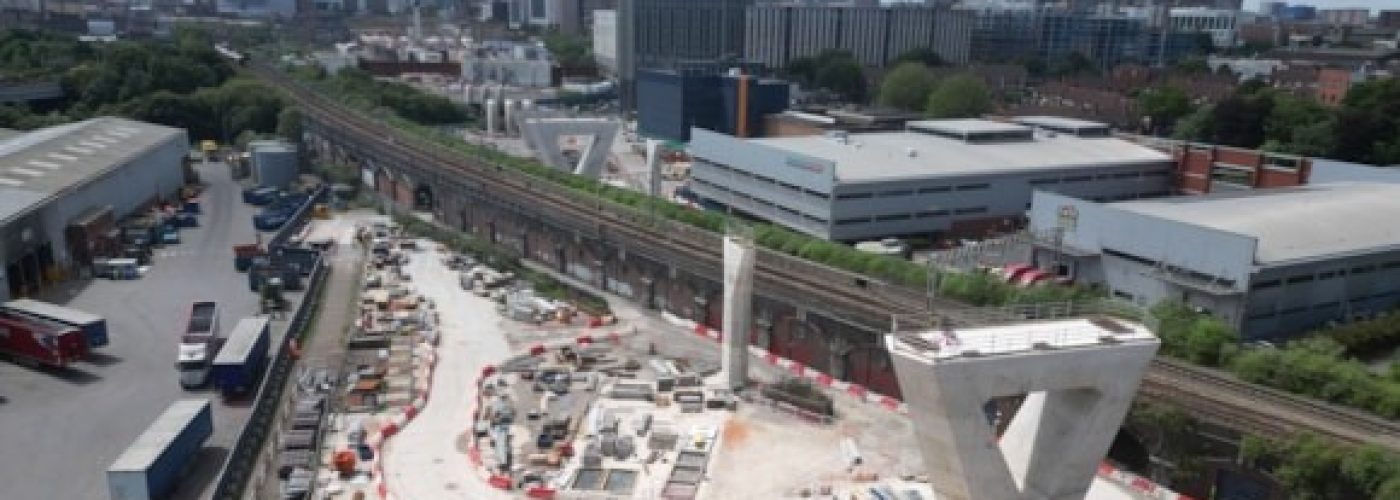- Giant piers completed for the 150-metre-long HS2 superstructure which will take high-speed trains in and out of Birmingham.
- Dubbed the “Bellingham Bridge” by the HS2 team after England footballer Jude Bellingham – the bridge is designed to celebrate the area’s industrial heritage and make a striking addition to the city’s skyline.
HS2 has completed the four huge piers of the Curzon 2 bridge, marking a significant construction milestone on the sequence of viaducts that will take high-speed trains in and out of Birmingham.
The bridge, which has been nicknamed “Bellingham Bridge” in honour of England superstar and Stourbridge-born Jude Bellingham, is the tallest structure in the one-mile stretch of connected viaducts being built through the city’s industrial heartland.
It will carry high-speed trains over the existing Victorian brick rail viaduct, with a 25-metre-high curved truss displaying a vibrant light installation which will create a new icon on the city’s skyline.
Work began on the four piers in Autumn 2023, with each structure now standing 16 metres tall. Assembly of the deck and the curved truss in weathering steel, has now started and is set to complete by next Spring.
The 150-metre-long deck is being assembled on top of the seven piers of the adjacent Curzon 1 viaduct, with around 130 individual parts lifted by crane. The entire deck and truss structure, which weighs over 4,000 tonnes, will then be slid 190 metres into place onto the Curzon 2 piers using a jacking system. This operation is set to take place over 12 days in Summer 2025.
The viaduct includes a unique light installation, designed by British artist Liz West, which will introduce a dynamic colour palette to the apertures of the steel truss, framing views of the city. Titled Out of the Blue, the proposed public artwork will create a dramatic feature in Birmingham’s urban landscape.
As the gateway to Birmingham, high speed trains will travel out of the west portal of the 3.5 mile Bromford Tunnel at Washwood Heath and onto the one mile long stretch of five connected viaducts – Duddeston Junction, Curzon 1, Curzon 2, Lawley Middleway and Curzon 3 which links onto the platforms of Curzon Street Station.
The Curzon approach viaducts are being built by HS2’s West Midlands contractor Balfour Beatty VINCI, with a team of more than 250 people, including engineering apprentices, steel welders, steel fixers and joiners.
David King, Senior Project Manager at HS2 Ltd said:
“With the completion of these four huge viaduct piers, HS2’s gateway into Birmingham has taken another leap forward.
“Passengers travelling on the new high-speed trains will experience a fantastic entrance to the city as they emerge from Bromford Tunnel at Washwood Heath, and rise up onto this striking stretch of viaducts on the approach to the new state-of-the-art Curzon Street Station.”
Onder Akin, Senior Project Manager at Balfour Beatty VINCI said:
“This iconic bridge is part of a complex series of connected viaducts that will weave through Birmingham’s industrial heartland. I’m proud of how the BBV team has responded to the challenge of building these structures in such a busy urban space, working around existing rail lines and utilities.
“The completion of the four 16-metre-high piers to support the bridge shows the great progress we’re making, and the team is now preparing for the operation next year, which we believe will be among the longest bridge launches of its type ever delivered in the UK.”
The design for the Curzon Street approaches section has been developed by a Design Joint Venture of Mott MacDonald and Systra and architects Weston Williamson + Partners, all working for Balfour Beatty VINCI.
Nicholas Robertshaw, Design Project Director at Mott MacDonald SYSTRA Design Joint Venture said:
“It’s clear to see from the height of the completed piers that the Curzon 2 viaduct will be become an iconic part of Birmingham’s skyline, referencing the city’s industrial heritage.
“The work done to date is a testament to the collaborative efforts made by all parties to design this vital piece of transport infrastructure in a way which will benefit passengers and deliver a lasting legacy for the wider Birmingham community.”
A truss bridge is light but strong, composed of connected elements that form triangular units, and constructed using a relatively small amount of material. This makes the truss form ideal to assemble offline and then launch from one end and in one piece across the existing railway viaduct below.
The truss has been designed to ‘wrap’ around the viaduct, extending the bottom of the steel to wrap underneath the viaduct deck and forming a visual connection to the steel girders of the adjacent structures. The viaduct deck itself will carry three parallel high speed rail tracks over the existing east-west rail line.
When complete, HS2 will improve connections between London and the West Midlands, with trains running further north on existing lines. This new high speed railway will create quicker and far more reliable journeys, driving economic growth while crucially freeing up space for more local trains on the most congested part of the existing West Coast Main Line.
Building, Design & Construction Magazine | The Choice of Industry Professionals





